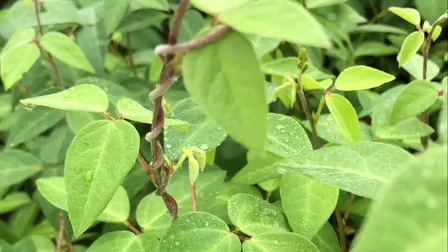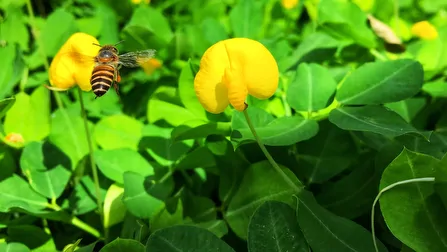
Indicação
É uma leguminosa indicadas a solos de baixa fertilidade. Tem boa adaptação/simbiose aos diversos tipos de Rhizobium do solo, portanto elevada absorção de nitrogênio atmosférico, e quando ingerida pelos bovinos fornece uma alimento de excelente qualidade nutricional (18 a 23% PB). Apesar disso, a palatabilidade é baixa, fator esse que confere uma persistência maior na pastagem consorciada. Possui boa tolerância a seca, e sensível à geada. Recomendada em consorciação com todas as gramíneas forrageiras.
Macrotyloma axillare cv. Java
Solos de baixa fertilidade
Pastejo consorciado com gramínea forrageira
5 a 9 t/ha/ano de matéria seca (M.S.)
18 a 23%
Em torno de 40cm
Alta
Média e baixa (favorece a persistência)
Boa
Média
Perene
Utilização e Manejo
A Java é uma leguminosa trepadeira, com excelente potencial de consorciação com as diversas variedades de pastagens presentes no mercado. Pelo fato da planta se enrolar nas folhas das pastagens, ela tem mais facilidade em se adaptar com tamanhos diferente de forrageiras. É indicada para solos de baixa fertilidade, principalmente com deficiência de nitrogênio. Por apresentar baixa palatabilidade os bovinos tendem a se alimentar de suas folhas com menos frequência, fator esse que auxilia na sua persistência nas pastagens consorciadas e também no seu manejo.
Origem
Resultado do cruzamento artificial entre as cultivares Guatá (IZ) e Archer (Australiano), feito pela Matsuda em 1999.
Características Morfológicas
Leguminosa de ciclo perene, herbácea, trepadeira volúvel, com ramos de fina pubescência, folhas trifoliadas, com folíolos elípticos de 6,1 cm de comprimento e 3,5 cm de largura e levemente pubescente em ambas as faces. Inflorescência racemosa com flores de cor amarela pálida.
Características Agronômicas
Planta adaptada a clima tropical e subtropical com precipitação acima de 900mm anuais, sensível a geada, recuperando-se bastante bem após a ocorrência da mesma. Outra característica importante desta leguminosa é sua boa adaptação a solos de baixa fertilidade, arenosos e ácidos, porém responde muito bem a adubação e em solos de boa fertilidade. Apresenta palatabilidade média a baixa, fator que auxilia na persistência da leguminosa, principalmente em associações com gramíneas e cresce em qualquer tipo de solo, desde que bem drenados. Tolera bem a seca e responde a adubação de fósforo e potássio. Planta bastante vigorosa e agressiva, produz flores e sementes durante todo o ano, concentrando o florescimento em junho. As vagens são deiscentes e elásticas e na maturação "atiram" as sementes às distâncias consideráveis (até 1m), promovendo uma expansão natural do cultivar na área. O potencial de produção de sementes é em torno de 350 a 500 kg/ha/ano.
